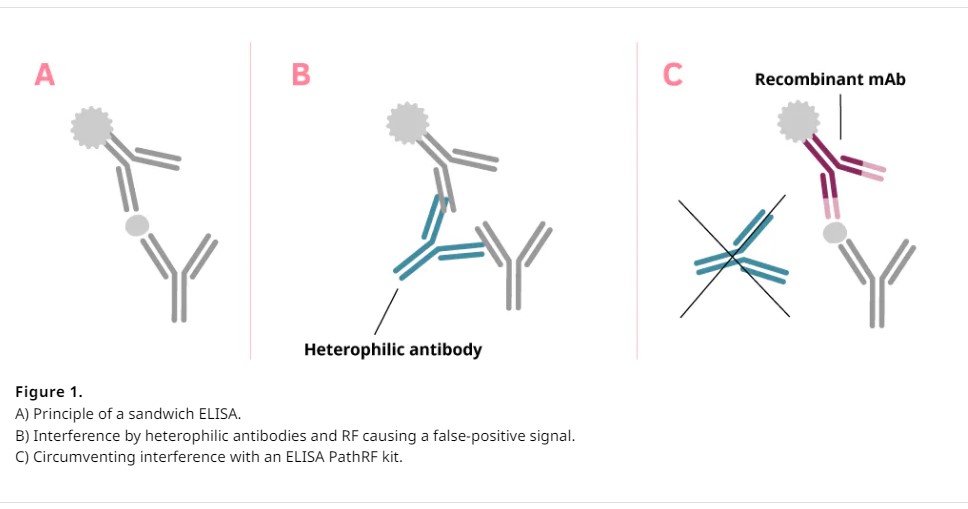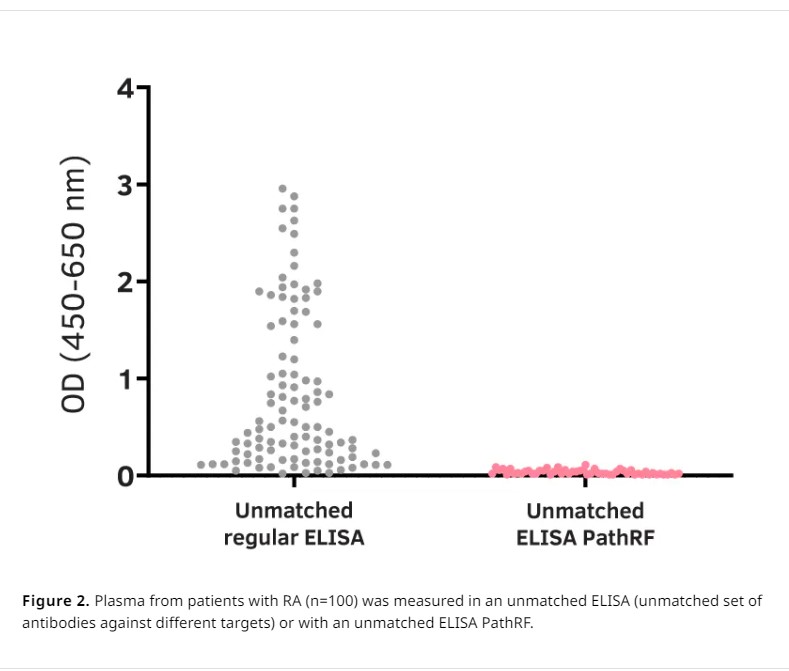ELISpot assay principle
The enzyme-linked immunospot (ELISpot) assay is an extremely sensitive immunoassay performed in a 96-well plate format to quantify protein secreting cells.
Analyzing samples from patients with ELISA? Watch out for heterophilic antibodies causing false positives. Learn how Mabtech’s kits overcome this issue.
Sandwich ELISAs use matched antibody pairs for the capture and detection of soluble analytes. When the analyte is present in the sample, a positive signal is measured (Fig. 1A). However, interfering factors in serum and plasma, such as rheumatoid factor (RF) and heterophilic antibodies, can crosslink the assay antibodies, which causes false-positive signals and inaccurate analyte quantification (Gehin et al. 2021) (Fig 1B). Cross-linking makes it impossible to distinguish between specific and non-specific signals and, ultimately, renders the results unreliable. Extra sample pre-treatment steps, for example, antibody removal by PEG 6000 precipitation or immunoglobulin blockade, have previously been suggested to reduce this interference (Bartels et al. 2011, Churchman et al. 2012).
RF was first found in patients with rheumatoid arthritis (RA) and has since been described in many conditions, including cancer, chronic infections, sarcoidosis, mixed connective tissue disease, Sjögren’s syndrome, and systemic lupus erythematosus (Ingegnoli et al. 2013, Tiwari et al. 2021). Therefore, the risk for false-positive results caused by the interfering RF and heterophilic antibodies is higher in samples from patients than in samples from “healthy controls” (Kharlamova et al. 2021).
To ensure that your data can be compared across different cohorts, consider switching to ELISA PathRF (Fig. 1C). In this ELISA format, the original antibody pair that specifically detects the analyte is still present but by introducing a recombinant backbone to the detection antibody and adding a specialized RF-block diluent, the risk of interference is circumvented.

RF (rheumatoid factor) is a variable mixture of many different antibodies; some of these antibodies bind other antibodies and some are autoantibodies (antibodies that bind self-antigens).
What are heterophilic antibodies?
Heterophilic antibodies bind other antibodies. In human samples, these are either autoantibodies that bind human immunoglobulins or human anti-animal immunoglobulin antibodies (HAIA), including human anti-mouse antibodies (HAMA).
An unmatched set of antibodies can be used to determine whether a signal obtained in an ELISA is a true or a false-positive signal. Such an unmatched set consists of capture and detection antibodies that bind to entirely different proteins. This unmatched set cannot result in a true signal. If, however, a signal is obtained, this shows that factors in the sample cross-link the capture and detection antibodies creating a false-positive signal.
In 100 plasma samples from individuals with rheumatoid arthritis, we observed a high frequency of false-positive results using an unmatched ELISA (Fig. 2). By contrast, the ELISA PathRF resulted in no false-positive signals (Fig. 2).

| ELISA PathRF: Human IFN-γ | 3420-1HP-DP-1 |
| ELISA PathRF: Human IL-1β | 3416-1HP-DP-1 |
| ELISA PathRF: Human IL-6 | 3460-1HP-DP-1 |
| ELISA PathRF: Human IL-8 | 3560-1HP-DP-1 |
| ELISA PathRF: Human IL-10 | 3430-1HP-DP-1 |
| ELISA PathRF: Human IL-17A | 3520-1HP-DP-1 |
| ELISA PathRF: Human TNF-α | 3512-1HP-DP-1 |
We gladly support you by keeping you updated on our latest products and the developments around our services.